Common weld symbols and their meanings
A set of symbols are shorthand for describing the type of weld, its size, and other processing and finishing information. You will often find these on engineering and fabrication drawings. Here we will introduce you to the common symbols and their meaning. American National Standards Institute (ANSI) and the American Welding Society (AWS) publish ANSI/AWS A2.4, Symbols for Welding and Nondestructive Testing, which provides a complete set of symbols.
The structure of the welding symbol
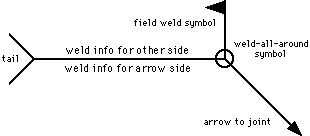
The horizontal line — called the reference line — is the anchor for all welding symbols. You'll find instructions for making the weld strung along the reference line. An arrow connects the reference line to the joint that is to be welded. In the example above, you'll see the arrow growing out of the right end of the reference line and heading down and to the right, but standards allow many other combinations.
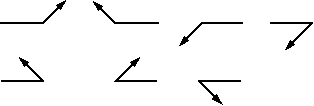
There are often two sides to the joint to which the arrow points, and therefore two potential places for a weld. For example, when joining two steel plates into a T shape, you may weld on either side of the T.

The weld symbol distinguishes between the two sides by using the arrow and the spaces above and below the reference line. The side of the joint to which the arrow points is known as the arrow side, and that weld's instructions are given below the reference line. The other side of the joint is known as the other side, and you'll weld according to the instructions found above the reference line. This rule applies regardless of the arrow’s direction.
The flag growing out of the junction of the reference line and the arrow is present when completing the weld in the field during erection of the structure. A weld symbol without a flag indicates that the weld is to be made in the shop. Older drawings may denote a field weld by a filled black circle at the junction between the arrow and reference line.
The open circle at the arrow/reference line junction indicates a weld is to go all around the joint, as in the example below.
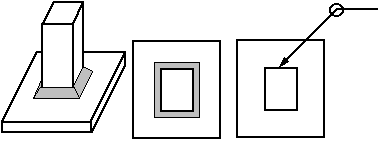
The tail of the weld symbol is the place for supplementary information on the weld. It may reference the welding process, electrode or any helpful information that doesn't have a place on the symbol.
Types of welds and their symbols
Each welding position has its own basic symbol. This is typically placed near the center of the reference line (and above or below it, depending on which side of the joint it's on). The symbol is a small drawing that represents a simplified cross-section of the weld. In the descriptions below, the symbol is shown in both its arrow-side and other-side positions.
Fillet Weld

|
Groove Welds

|
Plug Welds and Slot
Welds

|
Fillet welds

Welders use the fillet weld (pronounced "fill-it") to make lap joints, corner joints and T joints. The fillet weld is roughly triangular in cross-section, although it is not always a right triangle or an isosceles triangle. The operator deposits metal in a corner formed by the fit-up of the two members. This metal penetrates and fuses with the base metal to form the joint. (Note: for the sake of graphical clarity, the drawings below do not show the penetration of the weld metal. Recognize, however, that the degree of penetration is important in determining the quality of the weld.)

You'll find the perpendicular leg of the triangle on the left side of the symbol, regardless of the weld orientation. You'll also find the leg size to the left of the weld symbol. If the two legs of the weld are to be the same size, only one dimension is given. If the weld is to have unequal legs, both dimensions are given. There is also an indication on the drawing as to which leg is longer. 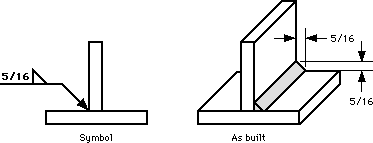
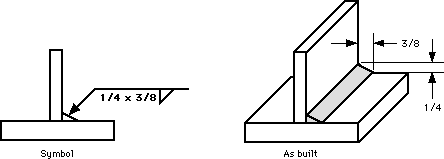
Find the length of the weld to the right of the symbol.
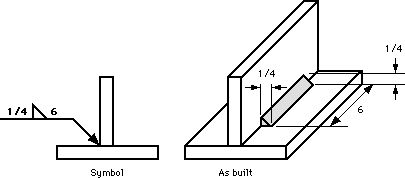
If there is no length, place the weld between specified dimension lines (if given) or between those points where an abrupt change in the weld direction would occur (like at the end of the plates in the example above).
For intermittent welds, a dash separates the length of each portion of the weld and the spacing of the welds (length first, spacing second). You'll find this to the right of the fillet weld symbol.
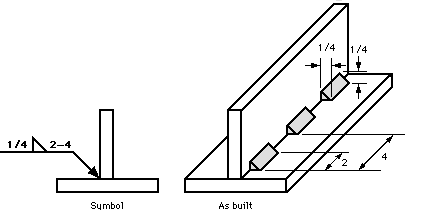
Notice that the spacing, or pitch, is not the clear space between the welds, but the center-to-center (or end-to-end) distance.
Groove welds

When making edge-to-edge joints, you'll most likely use a groove weld. Welders might also use it in corner joints, T joints, and joints between curved and flat pieces. As suggested by the variety of groove weld symbols, there are many ways to make a groove weld. The differences depend primarily on the geometry of the parts to be joined and the preparation of their edges. Operators deposit weld metal within the groove, which and penetrates and fuses with the base metal to form the joint. (Note: for the sake of graphical clarity, the drawings below generally do not show the penetration of the weld metal. Recognize, however, that the degree of penetration is important in determining the quality of the weld.)
The various types of groove welds are:
Square groove welds
The groove is created by either a tight fit or a slight separation of the edges. You'll find the amount of separation, if any, on the weld symbol.
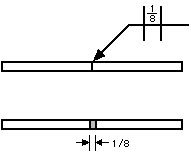
V-groove welds
The edges of both pieces are chamfered, either singly or doubly, to create the groove. You'll see the angle of the V on the weld symbol, as is the separation at the root (if any).
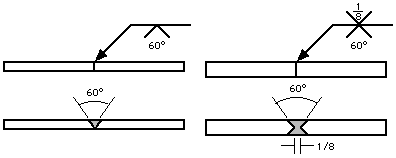
If the depth of the V is not the full thickness — or half the thickness in the case of a double V — the depth is given to the left of the weld symbol.
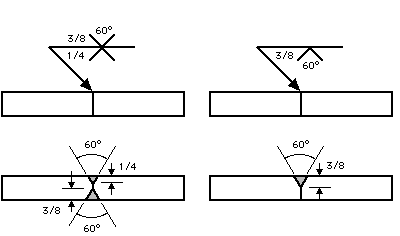
If the penetration of the weld is greater than the depth of the groove, you'll see the depth of the effective throat in parentheses after the depth of the V.
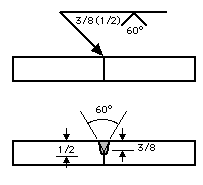
Bevel groove welds
The edge of one of the pieces is chamfered and the other is left square. Operators will find the bevel symbol's perpendicular line on the left side, regardless of the orientation of the weld. The arrow points toward the chamfered piece. A break in the arrow line emphasizes this extra significance. (The break isn't necessary if the designer has no preference as to which piece gets the edge treatment or if the piece to be treated should be obvious.) Angle and depth of edge treatment, effective throat and separation at the root are described using the methods discussed in the V-groove section.
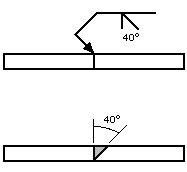
U-groove welds
The edges of both pieces are given a concave treatment. Depth of edge treatment, effective throat and separation at the root are described using the methods discussed in the V-groove section.
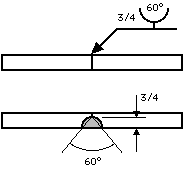
J-groove welds
The edge of one of the pieces is given a concave treatment and the other is left square. It is to the U-groove weld what the bevel groove weld is to the V-groove weld. As with the bevel, you'll find the perpendicular line on the left side. The arrow (with a break, if necessary) points to the piece that receives the edge treatment. Depth of edge treatment, effective throat and separation at the root are described using the methods discussed in the V-groove section.
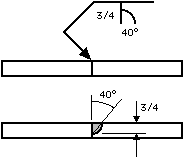
Flare-V groove welds
Commonly used to join two rounded or curved parts. You'll find the intended depth of the weld in parentheses to the left of the symbol.
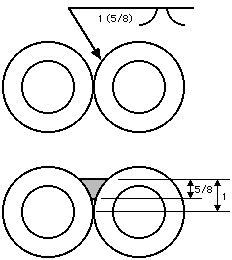
Flare bevel groove weld
Commonly used to join a round or curved piece to a flat piece. You'll find the depth of the groove and the intended depth of the weld (in parentheses) to the symbol's left. The symbol's perpendicular line is always on the left side, regardless of the orientation of the weld itself.
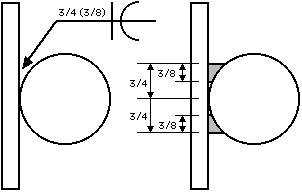
Common supplementary symbols used with groove welds are the melt-thru and backing bar symbols. Both symbols indicate making the complete joint penetration with a single-sided groove weld. In the case of melt-thru, reinforce the root with weld metal on the back side of the joint. You'll find the height of the reinforcement, if critical, to the left of the melt-thru symbol, which is across the reference line from the basic weld symbol.
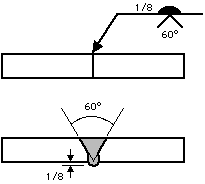
When you need to use a backing bar to achieve complete joint penetration, you'll see its symbol across the reference line from the basic weld symbol. You will find an "R" within the backing bar symbol if you need to remove the bar after completing the weld. The backing bar symbol has the same shape as the plug or slot weld symbol, but context should always make the symbol's intention clear.
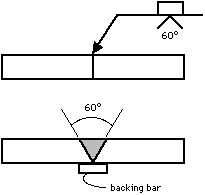
Plug and slot welds

Welders use plug welds and slot welds to join overlapping members, one of which has holes (round for plug welds, elongated for slot welds) in it. Weld metal is deposited in the holes and penetrates and fuses with the base metal of the two members to form the joint. (Note: for the sake of graphical clarity, the drawings below do not show the penetration of the weld metal. Recognize, however, that the degree of penetration is important in determining the quality of the weld.) For plug welds, you'll the diameter of each plug to the left of the symbol. Find plug-to-plug spacing (pitch) to the right.
For slot welds, find the width of each slot to the left of the symbol. You'll see the length and pitch (separated by a dash) to the right of the symbol, with a detail drawing in the tail. Find the number of plugs or slots in parentheses above or below the weld symbol. The arrow-side and other-side designations indicate which piece contains the hole(s). If the hole is not to be completely filled with weld metal, the weld symbol provides the depth to which it is to be filled.
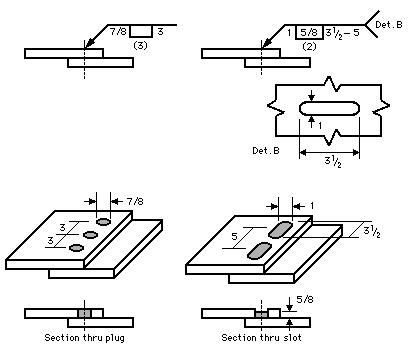
Conclusion
Weld symbols can be confusing if you don't know what you're looking at.
By understanding the types of welds and their corresponding symbols, as well as the structure of a welding symbol, you'll be able to decipher even the most complex welding diagrams.
If you're still unsure after reading this article, don't hesitate to reach out to an expert or see ANSI/AWS A2.4, Symbols for Welding and Nondestructive Testing.